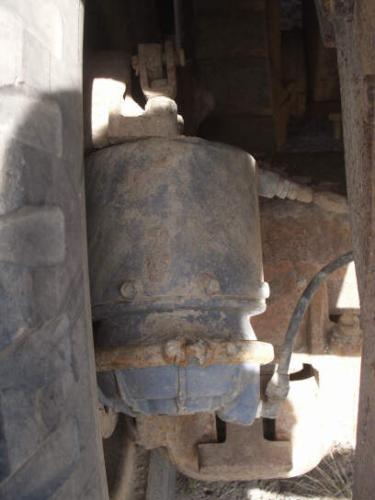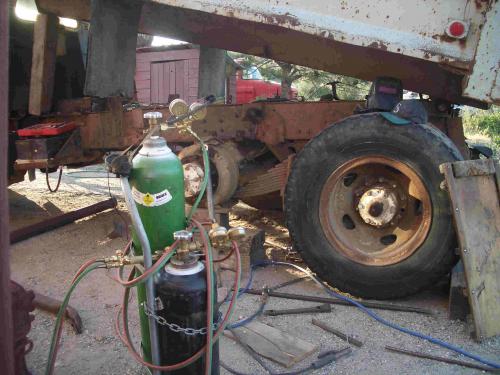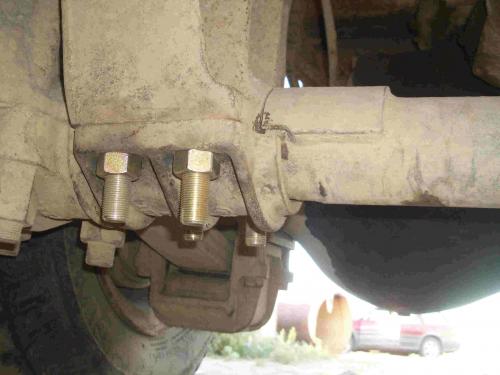
martinf
Puppy Poster-
Posts
47 -
Joined
-
Last visited
Content Type
Profiles
Forums
Gallery
Events
Blogs
BMT Wiki
Collections
Store
Everything posted by martinf
-
Need help with my injection pump
martinf replied to martinf's topic in Antique and Classic Mack Trucks General Discussion
That was my first thought as well, but there's not much room in there with the turbo right in front of it...and i also wonder about getting metal shavings in my injection pump! Even so, i may try this first before pulling the pump. -
Hi all, Ive got a 1964 B75 dump truck with a 672 that i keep in running order and use occasionally up at my place. Its pretty rusty, but I love it. Unfortunately, I broke off the tee fitting on the injection pump where the return lines come together before going back to the tank. I was attempting to remove this brass fitting because I couldnt get at the stop lever below it which i was messing with cause my engine stop cable is all rusted up and not functional. Anyways, attempting to remove it, I twisted off the nipple going into the injector pump, which is a Bosch, i beleive. My question is this: how difficult is it to remove the whole injection pump unit? My turbo is right in front of it, so thats a pia. According to my manual, as long as i dont turn the engine, i wont lose my timing. Any tricks or warning you have to offer will definitely be appreciated!
-
B fuel tank gunk
martinf replied to martinf's topic in Antique and Classic Mack Trucks General Discussion
I found out that acetone dissolves it quite well. I've got the tank removed, as much tar dripped out of the bottom as I wa s able and now I've got a gallon of acetone in there...we'll see! -
B fuel tank gunk
martinf replied to martinf's topic in Antique and Classic Mack Trucks General Discussion
Hmmn, boiled...like I could rig up a big drum full of water over a fire and put the tank in and boil it with the outlet stem pointed down so the gunk flowed out? i know, sounds kinda desperate, but I'm out in the sticks and not a lot of extra cash available! -
Hi all, i had a bunch of gunk in the bottom of my tanks. I found this out cause it was plugging up my lift pump and filter. Man, is that stuff nasty. Just like tar and pretty much undissolvable with fresh diesel or even gas. After getting the diesel out, I parked my truck at a steep downhill slant and removed the supply hoses and let this stuff ooze out. About a gallon or two came out of each tank. i think I ended up with all this since my dump truck sits for a couple of years at a time and out in the hot summer sun the tar separates out of the diesel and sinks to the bottom. anyways, I'm not writing to whine. Yesterday I was going to use the truck and it wouldn't run for lack of fuel...yep more tar plugging the supply lines. Dang it. I'm gonna have to drop these tanks and get them steam cleaned, right? I thought before I pulled them I'd ask you guys if you had any tips or tricks or alternate solutions to taking the tanks off and into town. thanks, martin
-
Thanks, guys. I'll check it out
-
Hey all, woke up my mid seventies R six wheel logging truck after 6 years of sitting. Builds up pressure just fine, but when I press the brakes, a huge gush of air comes out the side of the treadle valve. I've not taken this valve out before, but it's coming out on the passenger side on a port of some King. Is that a exhaust vent? anyways, when I do that, the air cans nd brakes operate, but I lose way too much air. also, for reasons I haven't figured out, but I'm thinking are related, there's no air coming too my spring cans and when I operate the brake hand control unit, air dumps out of the treadle at that same port. ideas and suggestions sure appreciated! martin
-
spring brakes
martinf replied to martinf's topic in Antique and Classic Mack Trucks General Discussion
Yeah, that's about how I look! -
spring brakes
martinf replied to martinf's topic in Antique and Classic Mack Trucks General Discussion
Thanks for the suggestions guys. For some reason I have no air coming back to the spring brakes...and when I press in the treadle, the a huge gush of air coming out of the treadle valve. This girl ran ok when I parked her 6 years ago. I don't have the time right now to problem solve...just neede to move her. So that's why I'll just do the caging bolts quick. If you have any ideas about the bigger issue tho, I'm all ears. thanks martin -
Having problems getting my spring brake cans aired up on my mid seventies R. I was going to put the bolt in and lock them so I could move it over to my shop (100 ft)...those bolts are missing on both cans! They're usually in that little holder on the can itself right? Anyways I've seen these things plenty of times, but I can't quite picture them enough to make them. How bout all thread with a pin welded across the top? Or is there a place I can buy them cheap and quick? Thanks for any advice. Martin
-
B series fuel pump question
martinf replied to martinf's topic in Antique and Classic Mack Trucks General Discussion
Cleaning the lines is easy, but how would you go about cleaning the tanks. I've drained them but fresh diesel is not going to dissolve that molasses sludge. I hate take them off and get them steam cleaned and tho gasoline dissolves the sludge, I don't like the idea of any leftover gas being in the tank when I refuel. martin -
B series fuel pump question
martinf replied to martinf's topic in Antique and Classic Mack Trucks General Discussion
Well guess what came out of the supply line petcocks on both tanks? Molasses! I've never seen anything this bad before. A gallon of the blackest ooze you could ever imagine. i haven't run this truck in 8 years and it sat lots before that. And when I got her running and parked it at my digging site to load with rock, she sat pointed downhill. And that ooze was filling up other fuel line between the tanks and half way up the supply hose to the pump. Poor pump...no wonder it couldn't pull fuel. makes me want to paint my fuel tanks white so they don't become solar ovens in the summer sun all season year after year! -
B series fuel pump question
martinf replied to martinf's topic in Antique and Classic Mack Trucks General Discussion
Thanks guys. All good suggestions. Just woke up to find it snowing hard so my Macks gonna have to sit for a while til it melts. Sigh. martin -
Hey all, ive got a midsixties B75 with a thermodyne engine. I needed to use it but after sitting for half dozen years or so, it quit a minute or two after start up. Turns out the supply pump, APE, wasn't delivering fuel. ..and the hand primer wasn't pulling in fuel either. Turns out the pump cavity was empty and, after filling it with diesel (pulled off the primer body and lifted the check valve) I got the hand primer working and pushed fuel up into the injection pump and all was well. But...now after a couple of days it's doing it again.. Won't run and primer pump won't pull in fuel and push it over to the filter. I probably have hunky old fuel, don't you think? I'll empty the tanks and put in fresh diesel and flush the line up to the pump. Any other ideas? Also, are repair parts available for these little plunger pumps? Or even rebuilt units? thanks for any assistance. martin
-
Not Enough Air In My "b"
martinf replied to martinf's topic in Antique and Classic Mack Trucks General Discussion
Just to give anyone who's interested an update... I put in a new governer and that solved the lack of air problem. Wow. I've never had it build up so much pressure so quickly! And it fixed my other problems with the leaky power cylinders, too (at least for a while). When there was only 30 psi, the cylinders leaked bad, but with strong pressure they don't. Well, and also I cleaned then up and got the rust out and put a shot of 5W in there like the book said. I guess I probably wouldn't have had to even take them off and apart, if it wasn't for the low air pressure making them leaky and me getting worried about them, but I guess it's a good thing I did because they really needed some maintainence. It'll be a good thing if I can get a few more years out of them as I've learned here how difficult it will be to replace them or create a work around. Thanks again, ~martin -
Not Enough Air In My "b"
martinf replied to martinf's topic in Antique and Classic Mack Trucks General Discussion
Alrighty, Well, looking in a another Mack manual, I see a picture of the roto chambers and then mine, which they call power cylinders. If I'm not able to get new rubber sealing lips for the pistons, I'll be changing over to the diaphram air brake service chambers on the front rear axle. Don't know about the fit issue, though, because the 24's need 7 1/2" dia. and my power cylinders are a bit over 6" dia. and not much more room to spare. Any ideas about how to accomodate the larger diameter chambers? And, if anybody's got the book handy, I'd appreciate a look-up for my axle ratings. The number on the housing is 1QFA5408P1. I'd imagine that they are 44,000's, though because HK Trucking identified them as such and, looking on my title, it shows gross weight of 44,000. By the way, Rob, this truck is a 1965. And, since you asked, I took a picture today of the rear spring cans. thanks for the assistance, I'm learning lots of this site. ~martin -
Not Enough Air In My "b"
martinf replied to martinf's topic in Antique and Classic Mack Trucks General Discussion
My furthest back axle has spring brake chambers on it, and I don't think I have a driveshaft brake. If I can ask yet another question...how do I tell if my rears are 38,000# or ? Here's a couple of pics, in case that'll help. Again, thanks, ~martin -
Not Enough Air In My "b"
martinf replied to martinf's topic in Antique and Classic Mack Trucks General Discussion
Yep, mine have the air inlet in the center back end and definately are not pancake diaphram, so I bet they are roto chambers. I looked for sources for new 24's and came up with this. I'm surprised how inexpensive these are...definately not worth re-building my roto chambers if I can substitute these. Would these do the trick? They are the right bolt size and bolt spacing. http://shop.easternmarine.com/index.cfm?fuseaction=catalog.prodInfo&productID=8502&categoryID=471 Thanks again, Rob, for all your assistance. I'm learning as I go here! ~martin -
Not Enough Air In My "b"
martinf replied to martinf's topic in Antique and Classic Mack Trucks General Discussion
Yep, good point and I won't mess around with compromised brakes. How about my question about if my air chambers are the roto type you mentioned? WOuld like to know aboutthat. As I had mentioned, mine are the kind with a metal piston and a rubber sealing lip and a felt ring a bit lower on the piston side. Are these roto's or are rotochambers the kind with the rubber diaphram fully across the chamber? Boy, those seem like an improvement in terms of sealing reliability.... ~martin -
Not Enough Air In My "b"
martinf replied to martinf's topic in Antique and Classic Mack Trucks General Discussion
Thanks for the info. Mine don't have a rubber diaphram that goes across the entire chamber, like some air brakes I've seen. Mine are just a metal piston with a rubber sealing lip and expander spring kinda like a large hydaulic brake master cylinder rubber cup. There's also a felt ring in a large grove in the piston side. Is that a roto chamber, or something else? And now here' a total newbie question: SInce I only had 30 lbs of air in the system (because my governor wasn't working right), is it possible for the sealing lips to not spread out enough and, therefore, lots of air leak by? I ask because it seems kinda crazy that, last fall, the brakes were working okay (a little leakage, but not much) and then now, firing it up the first time this Spring, when I press the brakes, BOTH these air brake chambers leak like crazy. thanks for the help, Rob and all ~martin -
Not Enough Air In My "b"
martinf replied to martinf's topic in Antique and Classic Mack Trucks General Discussion
Okay, got the governor taken care of. Now I noticed that I lose some air when hitting the brakes and sourced the leak to the air brake cans on the middle axle. Not the spring locking, just the regular. Got them off and apart and I see that they're pretty rusty insode with some pitting. How picky are these units to get a reasonable seal? Do they need perfecty smooth side walls or can you even clean them up with a cylinder hone and some sandpaper? And, is replacing the lockheed wagner rubber seals advisable or can I get a way with reusing them if they look fairly decent? What's a good source for getting those rubber seals? I would imagine that a complete new brake unit is spendy, but can you get just a new can? And when rebuilding them should I use oil or grease? Thanks for any advice. I want to get them to not leak, of course, but my budget is pretty tight these days and I only use the truck a few times a year so it's not like I have to get it perfect for full time road work. ~martin -
Not Enough Air In My "b"
martinf replied to martinf's topic in Antique and Classic Mack Trucks General Discussion
Thanks, everyone. Where's the best place to get a governor? And, are these Mack specific or generic? ~martin -
Hey gang. Was going to wake up my B-75 (early 60's model) to do some work and I only get 30 lbs of air pressure, not even enough to keep my seat up! before I start digging into it, was looking for some advice... Doesn't seem like it would be gunked up air intake filter as this one draws thru the engine air intake. And doesn't seem like the compressor would all of a suden go bad (rings or whatever)...what's most likely, governor not operating correctly, stuck intake valves or crappy exaust one-way valve? Yes, I've checked and I'm not leaking air out the lines or cans or anything as I stopped the engine and listened close everywhere and no hissing anywhere. I'm assuming that'senoeugh of a check to know that the problem is on the air production side, not that there';s a leak so big that the compressor can't build up enough pressure. Anyways, thanks for any ideas or advice. ~martin
-
Where To Go From Here
martinf replied to martinf's topic in Antique and Classic Mack Trucks General Discussion
Out here in the Pacific NW these log self-loaders are pretty common. I'll be using mine in a fairly unusual way: I'm mounting it on a WWII barge boat that I am restoring. 60,000 lbs of 1/4" steel 40' long and 13' wide with two Chrystler straight 8 engines spinning two 54" propellers. The Prentice log loader will be on the deck towards the front where I'll be picking up logs and moving/stashing them around for the Forest Service. I'm doing this on the lake I live on, 60 miles long, half-mile long and 1500 ft deep. I'm not so much trying to make a lot of money--just have somebody else paying for my fule while I motor around this incredible lake. I'm hoping that the Mack will work out for me. It's got a 20 speed and that, coupled with a low boy, aught to work fine to pull my boat in and out of the lake. I've got more questions for you guys about other issues regarding this project, but, for now I gotta figure out this wet cylinder thing. ~martin info about this project at www.seamule.blogspot.com -
Where To Go From Here
martinf replied to martinf's topic in Antique and Classic Mack Trucks General Discussion
Stupid question time: what does CPL stand for? thanks for all the great info, martin
BigMackTrucks.com
BigMackTrucks.com is a support forum for antique, classic and modern Mack Trucks! The forum is owned and maintained by Watt's Truck Center, Inc. an independent, full service Mack dealer. The forums are not affiliated with Mack Trucks, Inc.
Our Vendors and Advertisers
Thank you for your support!





